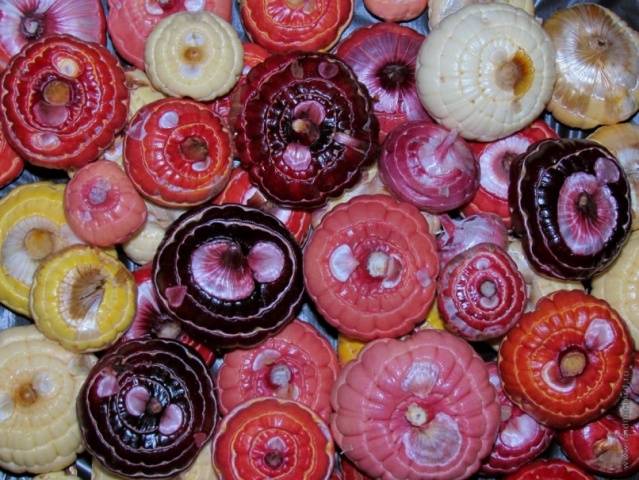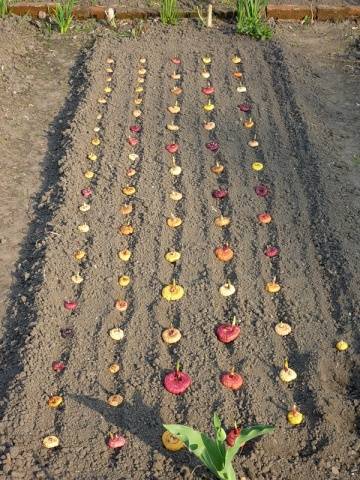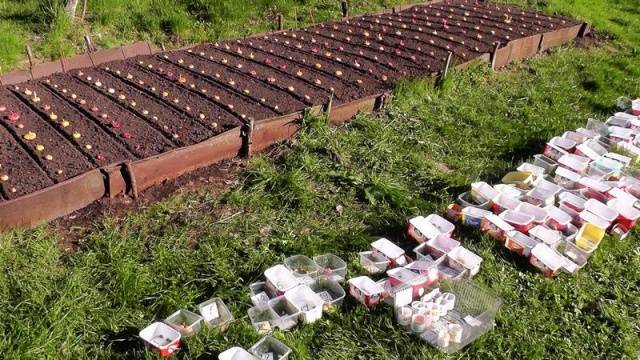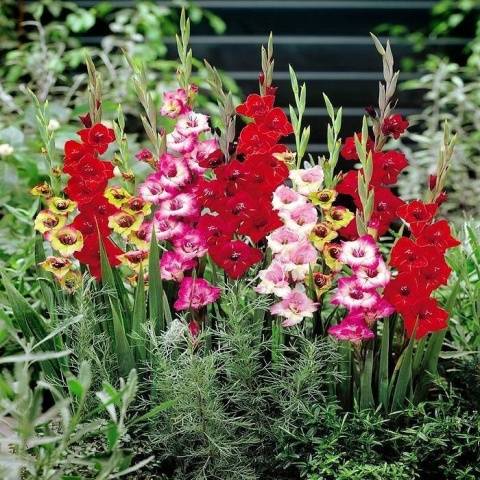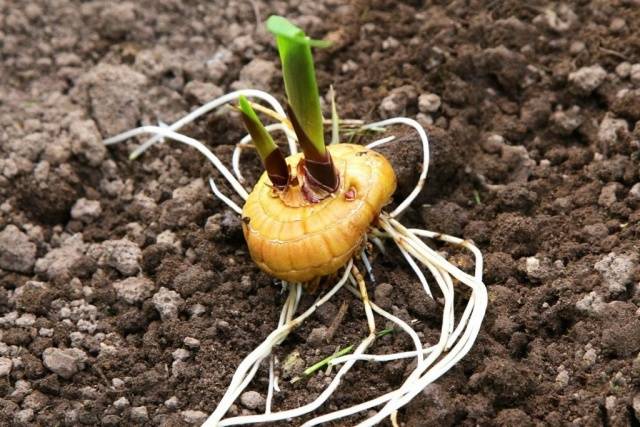Content
One of the first flowers that people began to use in their gardens were gladioli. Planting gladioli in the ground in the spring can seem like a very simple and not requiring specific knowledge process. But this is not the case. The hostess, who at least once planted these flowers in her garden, knows: so that gladioli bloom in large inflorescences, have a tall and strong stem, you need to properly store the bulbs of these flowers and know exactly when to plant gladioli in open ground... This is what this article will be about.
Planting gladioli in open ground
To figure out how to properly plant gladioli in the spring, you need to know the features of these flowers.
Gladioli were grown in ancient Rome, they were the favorite flowers of the Egyptian pharaohs, were considered the amulet of gladiators. These flowers are also called the skewer for the fact that the pointed and long leaves look like weapons.
The skewer should be grown in well-lit areas, this flower loves the sun. A strong wind or draft is detrimental to gladiolus, because these are tall plants with long stems that can easily break.
The soil for the skewer should be loose, not prone to moisture accumulation. The best soil for a flower will be sandy soil with the addition of peat and humus.
Gladiolus bulbs
Skewer is a bulbous plant, that is, it multiplies by forming small shoots on the tubers - "children". Due to the fact that the climate in Russia is quite harsh, winters are frosty and cold, gladiolus bulbs in the fall, you have to dig up and store until the next season in basements.
Usually, the skewer tubers are dug up in October, when the flower has faded, and its stem becomes dry and easily separates from the tuber. The collected bulbs need to be examined, to identify sick or rotten, sluggish specimens. It is better to discard such tubers right away - they will not be able to overwinter and turn into beautiful flowers next season.
The rest of the bulbs are left without removing the husk, placed in the sand and lowered into the cellar or basement. There, the skewer tubers remain until spring.
When to plant gladioli outdoors
Many florists who grow flowers for sale grow gladioli in greenhouses and heated greenhouses. In this case, the skewer bulbs are taken out for germination at the end of January or at the beginning of February. In 2.5-3 months the gardener will receive the first flowers and will be able to sell them profitably.
If it is supposed to plant gladioli in the spring in unprotected soil, it is necessary to raise the bulbs from the basements a little later.
There are several ways to grow a skewer:
- The usual method is to plant all the bulbs on the same day. To do this, you need to take into account the peculiarities of the climate in the region, and when, presumably, the earth warms up to 10 degrees, the germinated tubers can be planted in the holes.
- The continuous flowering method allows you to decorate your garden with flowering skewer from June to October. To do this, the first part of the bulbs is taken out for distillation at the beginning of March, each subsequent batch of tubers must be taken out for germination at intervals of two weeks. In the same sequence, tubers are planted in the holes, as a result, gladioli will bloom continuously, new plants will constantly replace those that have already faded.
- Taking into account the climatic zone is also very important - the skewer cannot be taken out into the open ground until the ground at a depth of 10 cm warms up to 10 degrees Celsius. Bulbs are afraid of frost, gladioli do not develop at low temperatures and lack of sun, in conditions of high humidity and prolonged rains, the tubers are easily affected by fungal infections and die. Therefore, the timing of planting gladiolus bulbs should be compared with the climate and weather in a particular region. For example, in Siberia, the skewer is planted not earlier than the first half of May, and in the middle lane, gladiolus bulbs are transferred to the holes in mid-April.
How to plant gladioli in spring
To grow beautiful and healthy flowers, you need to properly prepare the skewer bulbs for planting in open ground. To do this, on the appointed day, the tubers are taken out of the basement and carefully examined. First of all, soft and rotten tubers are removed, hard bulbs are cleaned from crusts and husks, and "babies" are separated from them (they must be grown separately).
If dark spots are found on the gladiolus bulbs, you can try to treat them. To do this, cut off the affected area with a sharp knife and cover the cut with brilliant green. Before disembarking to a permanent place, the "wound" should be tightened by the epidermis.
Before planting in the soil, you can do a preliminary germination of tubers - this will accelerate the flowering of gladioli, allow you to reject "dead" bulbs, from which nothing will grow.
Germination of skewer bulbs is performed in the following sequence:
- first of all, you need to disinfect the planting material. For this, the skewer tubers are placed for half an hour in a half-percent solution of potassium permanganate or any other antiseptic composition.
- In order for gladioli to have larger flowers, reach greater height and be healthier, the bulbs can be soaked in a boric acid solution (2 g per liter of warm water) for a couple of days.
- Plastic or wooden boxes or individual pots are filled with soil mixture: turf soil, humus, sand and peat. Wood ash, superphosphate and bone meal can be added to the same soil - all this contributes to the rapid development of gladioli.
- Depressions are made in the ground and some sand is poured there - the bulbs are placed on this layer and pressed a little.
- From above, the tubers are covered with soil mixture and watered with warm water.
- Until the first shoots appear, boxes with bulbs should be kept in a basement or other cool place with a temperature of 15 to 18 degrees.
- When sprouts appear, the boxes are brought out into the light: it can be a greenhouse, a veranda or a greenhouse. Here the land is regularly loosened, watered and fed every two weeks.
- When the weather permits, adolescents are taken out into the open ground (this should be done around mid-April).
It is not at all necessary to pre-grow gladioli, you can do with simpler preparation. The tubers removed from the basement and peeled are laid out in a warm place with constant access to sunlight (but not in direct sunlight).
Gladiolus bulbs are dried for a couple of days.
During this period, many gardeners recommend spraying the tubers with a spray bottle, however, it is better not to do this. In conditions of high humidity, roots will appear from the tubercles, which easily break off when gladioli are planted in a flower bed - this will slow down the growth of flowers and postpone the time of their flowering.
If the storage and preparation of gladiolus bulbs was carried out correctly, after a couple of days, root tubercles about three mm in size and sprouts from 1 to 10 cm in height will appear on the tubers.
Those specimens that remained in their original form (did not give any sprouts or tubercles) are thrown away.
Planting prepared bulbs in a flower bed
The main thing that a gardener should be able to do is to properly deepen the skewer bulbs. The rule here is: the size of the hole should be three times the diameter of the bulb. Then the gladiolus will be able to develop correctly and bloom quickly.
Pour a handful of dry sand into the prepared holes and carefully place the tubers there. Cover with dry earth and watered abundantly with warm water.
It is equally important to maintain a sufficient distance between the bushes. Gladioli are vigorous and tall plants, they should have enough water, light and nutrients. Therefore, it is impossible to plant the skewer close to each other - the distance between the holes should be at least 70 cm.
Flowers planted in this way will be large and strong.
Gladioli care
Taking care of gladioli planted on a flower bed is quite simple, you just need to perform a number of manipulations:
- When the sprouts reach eight centimeters, they need to be covered with a five centimeter layer of humus. This procedure is necessary in order to prevent excessive evaporation of moisture from the soil and to protect the stems from overheating.
- Once every two weeks, in the intervals between adjacent bushes, it is necessary to loosen the soil. Do this carefully, trying not to damage the bulbs and roots.
- Watering gladioli is necessary using a special technology. Not far from the stem, grooves are made, where water is poured. Watering flowers at the root can damage fragile leaves and stems.
- A tall skewer can break from the wind or under the weight of its own flowers, therefore, when the first buds appear, gladioli are tied to supports.
Growing gladioli is quite simple, the most difficult thing in this process is to decide when to plant gladioli in open ground in the spring. But these beautiful flowers will "thank" the owner for his work and will definitely become a worthy decoration of any garden.


